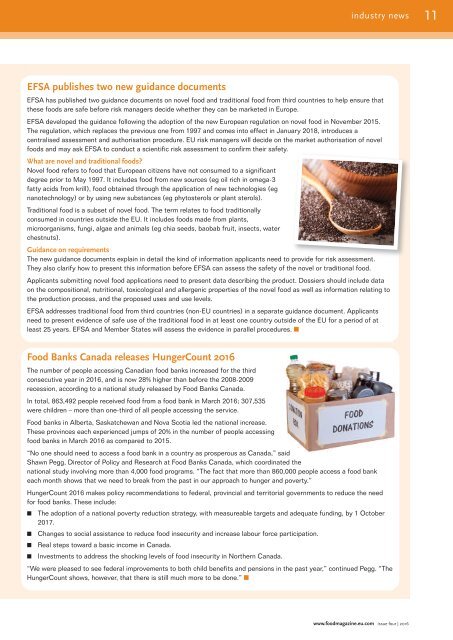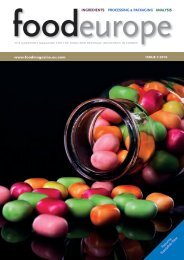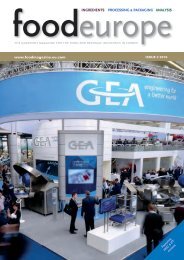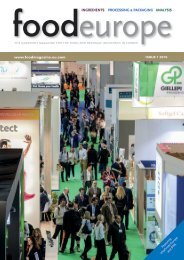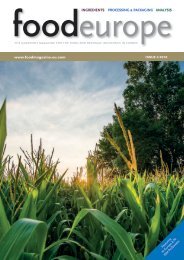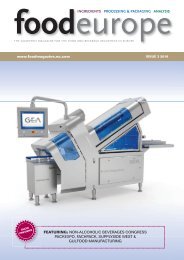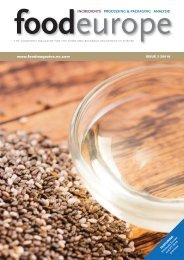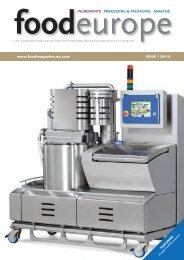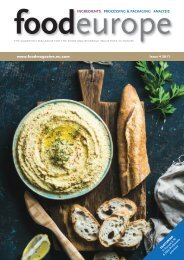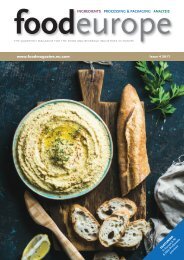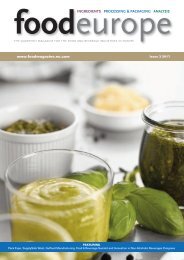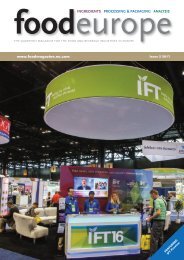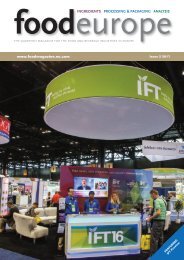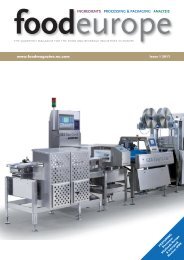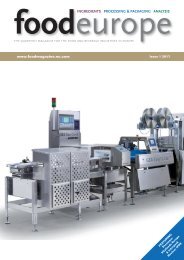FoodEurope Issue 4 2016
Create successful ePaper yourself
Turn your PDF publications into a flip-book with our unique Google optimized e-Paper software.
industry news<br />
11<br />
EFSA publishes two new guidance documents<br />
EFSA has published two guidance documents on novel food and traditional food from third countries to help ensure that<br />
these foods are safe before risk managers decide whether they can be marketed in Europe.<br />
EFSA developed the guidance following the adoption of the new European regulation on novel food in November 2015.<br />
The regulation, which replaces the previous one from 1997 and comes into effect in January 2018, introduces a<br />
centralised assessment and authorisation procedure. EU risk managers will decide on the market authorisation of novel<br />
foods and may ask EFSA to conduct a scientific risk assessment to confirm their safety.<br />
What are novel and traditional foods?<br />
Novel food refers to food that European citizens have not consumed to a significant<br />
degree prior to May 1997. It includes food from new sources (eg oil rich in omega-3<br />
fatty acids from krill), food obtained through the application of new technologies (eg<br />
nanotechnology) or by using new substances (eg phytosterols or plant sterols).<br />
Traditional food is a subset of novel food. The term relates to food traditionally<br />
consumed in countries outside the EU. It includes foods made from plants,<br />
microorganisms, fungi, algae and animals (eg chia seeds, baobab fruit, insects, water<br />
chestnuts).<br />
Guidance on requirements<br />
The new guidance documents explain in detail the kind of information applicants need to provide for risk assessment.<br />
They also clarify how to present this information before EFSA can assess the safety of the novel or traditional food.<br />
Applicants submitting novel food applications need to present data describing the product. Dossiers should include data<br />
on the compositional, nutritional, toxicological and allergenic properties of the novel food as well as information relating to<br />
the production process, and the proposed uses and use levels.<br />
EFSA addresses traditional food from third countries (non-EU countries) in a separate guidance document. Applicants<br />
need to present evidence of safe use of the traditional food in at least one country outside of the EU for a period of at<br />
least 25 years. EFSA and Member States will assess the evidence in parallel procedures. n<br />
Food Banks Canada releases HungerCount <strong>2016</strong><br />
The number of people accessing Canadian food banks increased for the third<br />
consecutive year in <strong>2016</strong>, and is now 28% higher than before the 2008-2009<br />
recession, according to a national study released by Food Banks Canada.<br />
In total, 863,492 people received food from a food bank in March <strong>2016</strong>; 307,535<br />
were children – more than one-third of all people accessing the service.<br />
Food banks in Alberta, Saskatchewan and Nova Scotia led the national increase.<br />
These provinces each experienced jumps of 20% in the number of people accessing<br />
food banks in March <strong>2016</strong> as compared to 2015.<br />
“No one should need to access a food bank in a country as prosperous as Canada,” said<br />
Shawn Pegg, Director of Policy and Research at Food Banks Canada, which coordinated the<br />
national study involving more than 4,000 food programs. “The fact that more than 860,000 people access a food bank<br />
each month shows that we need to break from the past in our approach to hunger and poverty.”<br />
HungerCount <strong>2016</strong> makes policy recommendations to federal, provincial and territorial governments to reduce the need<br />
for food banks. These include:<br />
n The adoption of a national poverty reduction strategy, with measureable targets and adequate funding, by 1 October<br />
2017.<br />
n Changes to social assistance to reduce food insecurity and increase labour force participation.<br />
n Real steps toward a basic income in Canada.<br />
n Investments to address the shocking levels of food insecurity in Northern Canada.<br />
“We were pleased to see federal improvements to both child benefits and pensions in the past year,” continued Pegg. “The<br />
HungerCount shows, however, that there is still much more to be done.” n<br />
www.foodmagazine.eu.com issue four | <strong>2016</strong>


